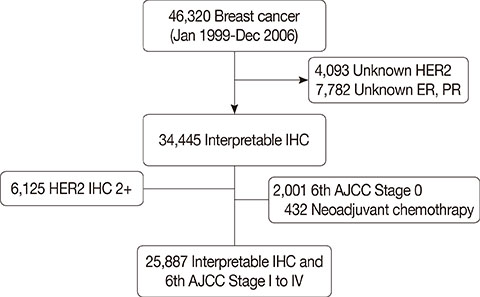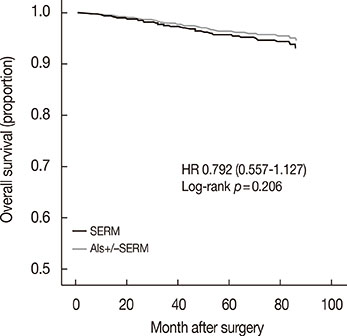J Breast Cancer.
2015 Mar;18(1):8-15. 10.4048/jbc.2015.18.1.8.
Survival Improvement in Korean Breast Cancer Patients Due to Increases in Early-Stage Cancers and Hormone Receptor Positive/HER2 Negative Subtypes: A Nationwide Registry-Based Study
- Affiliations
-
- 1Department of Surgery, Sun Medical Center, Daejeon, Korea.
- 2Department of Surgery, Seoul National University Hospital, Seoul, Korea. hanw@snu.ac.kr
- 3Department of Surgery, Samsung Medical Center, Seoul, Korea.
- 4Department of Surgery, Asan Medical Center, Seoul, Korea.
- 5Department of Surgery, Ewha Womans University Mokdong Hospital, Seoul, Korea.
- 6Department of Surgery, Dong-A University College of Medicine, Busan, Korea.
- KMID: 2286331
- DOI: http://doi.org/10.4048/jbc.2015.18.1.8
Abstract
- PURPOSE
The aim of this study was to investigate whether the observed changes over time in the survival rates vary according to the intrinsic subtypes of breast cancer diagnosed.
METHODS
Data from 46,320 breast cancer patients in the Korean Breast Cancer Registry who underwent surgery between 1999 and 2006 were reviewed. Among them, results from 25,887 patients with available data about the status of estrogen receptor, progesterone receptor, and human epidermal growth factor receptor 2 (HER2) were analyzed. Patients were classified into two cohorts according to the year in which they underwent surgery: 1999-2002 and 2003-2006.
RESULTS
The patients treated in the latter time period showed significantly better overall survival (OS) compared with those in the former period when adjusted for follow-up duration. The proportion of hormone receptor+/HER2-subtype and stage I breast cancer were significantly higher in the latter period (47.4% vs. 54.6%, p<0.001; 31.0% vs. 39.6%, p<0.001, respectively). Improvement in OS between the former and latter periods was seen in all subtypes of breast cancer, including triple-negative cancers (all p-values <0.001 in univariate and multivariate analyses).
CONCLUSION
Improvement in survival in Korean breast cancer patients over the study years is being observed in all subtypes of breast cancer, implying that increases in both early-stage detection and the proportion of less aggressive cancers contribute to this improvement.
Keyword
MeSH Terms
Figure
Cited by 1 articles
-
Chronological Improvement in Survival of Patients with Breast Cancer: A Large-Scale, Single-Center Study
Sae Byul Lee, Guiyun Sohn, Jisun Kim, Il Yong Chung, Hee Jeong Kim, Beom Seok Ko, Jong Won Lee, Byung Ho Son, Sung-Bae Kim, Sei-Hyun Ahn
J Breast Cancer. 2018;21(1):70-79. doi: 10.4048/jbc.2018.21.1.70.
Reference
-
1. Ko BS, Noh WC, Kang SS, Park BW, Kang EY, Paik NS, et al. Changing patterns in the clinical characteristics of Korean breast cancer from 1996-2010 using an online nationwide breast cancer database. J Breast Cancer. 2012; 15:393–400.
Article2. Korean Breast Cancer Society. Clinical characteristics of breast cancer patients in Korea in year 2000. J Korean Breast Cancer Soc. 2002; 5:217–224.3. The Korean Breast Cancer Society. Nationwide Korean breast cancer data of 2002 The Korean Breast Cancer Society. J Korean Breast Cancer Soc. 2004; 7:72–83.4. Jung YS, Na KY, Kim KS, Ahn SH, Lee SJ, Park HK, et al. Nation-wide Korean breast cancer data from 2008 using the breast cancer registration program. J Breast Cancer. 2011; 14:229–236.
Article5. The Korean Breast Cancer Society. Survival analysis of Korean breast cancer patients diagnosed between 1993 and 2002 in Korea: a nationwide study of the cancer registry. J Breast Cancer. 2006; 9:214–229.6. Perou CM, Sørlie T, Eisen MB, van de Rijn M, Jeffrey SS, Rees CA, et al. Molecular portraits of human breast tumours. Nature. 2000; 406:747–752.
Article7. Sørlie T, Perou CM, Tibshirani R, Aas T, Geisler S, Johnsen H, et al. Gene expression patterns of breast carcinomas distinguish tumor subclasses with clinical implications. Proc Natl Acad Sci U S A. 2001; 98:10869–10874.
Article8. Ahn SH, Son BH, Kim SW, Kim SI, Jeong J, Ko SS, et al. Poor outcome of hormone receptor-positive breast cancer at very young age is due to tamoxifen resistance: nationwide survival data in Korea--a report from the Korean Breast Cancer Society. J Clin Oncol. 2007; 25:2360–2368.
Article9. Shin HR, Won YJ, Jung KW, Kong HJ, Yim SH, Lee JK, et al. Nationwide cancer incidence in Korea, 1999.2001: first result using the national cancer incidence database. Cancer Res Treat. 2005; 37:325–331.
Article10. Hausauer AK, Keegan TH, Chang ET, Clarke CA. Recent breast cancer trends among Asian/Pacific Islander, Hispanic, and African-American women in the US: changes by tumor subtype. Breast Cancer Res. 2007; 9:R90.
Article11. Yamashita H, Iwase H, Toyama T, Takahashi S, Sugiura H, Yoshimoto N, et al. Estrogen receptor-positive breast cancer in Japanese women: trends in incidence, characteristics, and prognosis. Ann Oncol. 2011; 22:1318–1325.
Article12. Yang XR, Chang-Claude J, Goode EL, Couch FJ, Nevanlinna H, Milne RL, et al. Associations of breast cancer risk factors with tumor subtypes: a pooled analysis from the Breast Cancer Association Consortium studies. J Natl Cancer Inst. 2011; 103:250–263.13. Tamimi RM, Colditz GA, Hazra A, Baer HJ, Hankinson SE, Rosner B, et al. Traditional breast cancer risk factors in relation to molecular subtypes of breast cancer. Breast Cancer Res Treat. 2012; 131:159–167.
Article14. Yoo KY, Kim Y, Park SK, Kang D. Lifestyle, genetic susceptibility and future trends of breast cancer in Korea. Asian Pac J Cancer Prev. 2006; 7:679–682.15. Kim Y, Choi JY, Lee KM, Park SK, Ahn SH, Noh DY, et al. Dose-dependent protective effect of breast-feeding against breast cancer among ever-lactated women in Korea. Eur J Cancer Prev. 2007; 16:124–129.
Article16. Jung YS, Na KY, Kim KS, Ahn SH, Lee SJ, Park HK, et al. Nation-wide Korean breast cancer data from 2008 using the breast cancer registration program. J Breast Cancer. 2011; 14:229–236.
Article
- Full Text Links
- Actions
-
Cited
- CITED
-
- Close
- Share
- Similar articles
-
- Survival Analysis of Korean Breast Cancer Patients Diagnosed between 1993 and 2002 in Korea: A Nationwide Study of the Cancer Registry
- Clinical Differences in Triple-Positive Operable Breast Cancer Subtypes in Korean Patients: An Analysis of Korean Breast Cancer Registry Data
- Oncologic Effect of Oral Fluorouracil in Hormone Receptor-Negative T1a Node-Negative Breast Cancer Patients
- Hormone Treatment for Breast Cancer
- Expression and Role of Epithelial Membrane Proteins in Tumorigenesis of Hormone Receptor-Positive Breast Cancer





